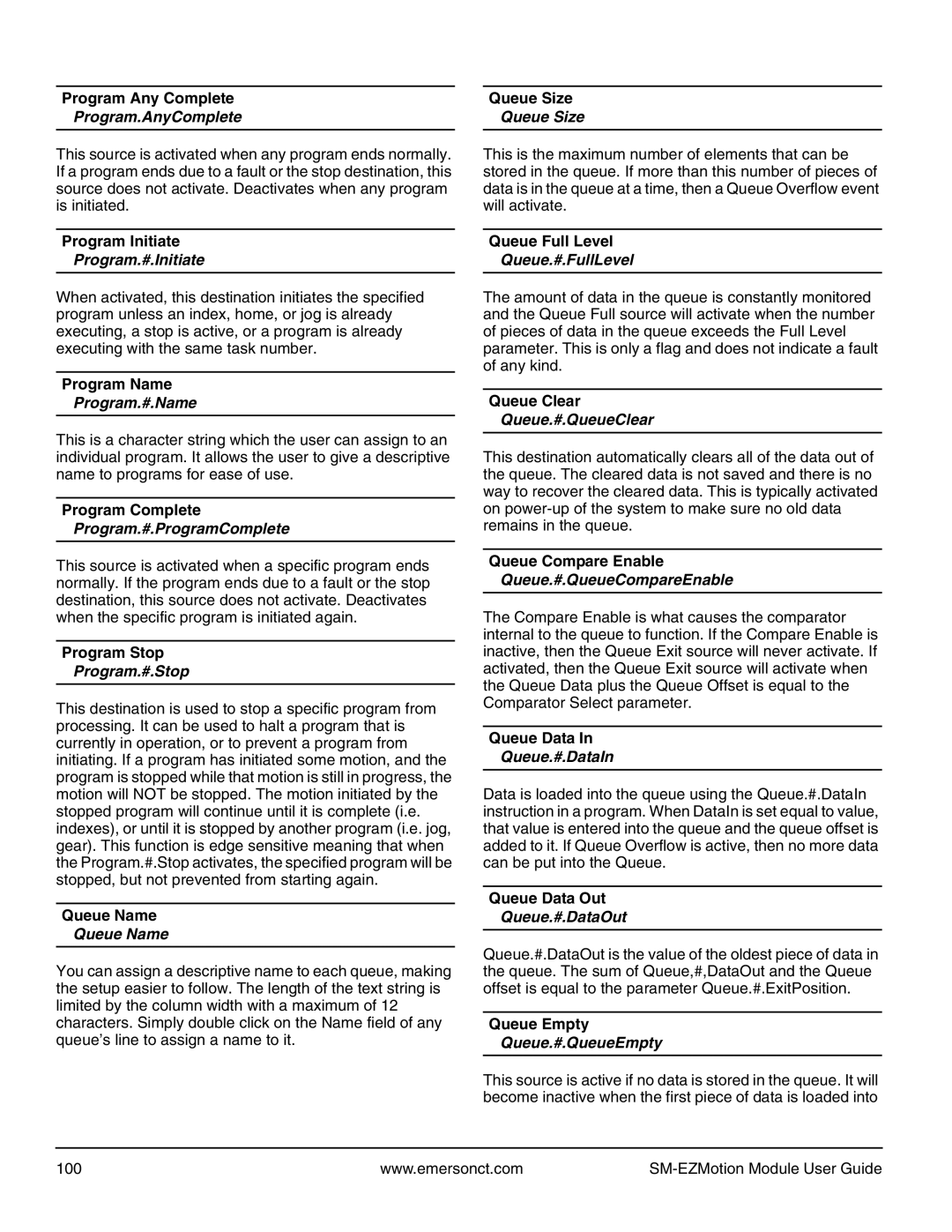
Program Any Complete |
| Queue Size |
Program.AnyComplete |
| Queue Size |
|
|
|
This source is activated when any program ends normally. If a program ends due to a fault or the stop destination, this source does not activate. Deactivates when any program is initiated.
Program Initiate
Program.#.Initiate
This is the maximum number of elements that can be stored in the queue. If more than this number of pieces of data is in the queue at a time, then a Queue Overflow event will activate.
Queue Full Level
Queue.#.FullLevel
When activated, this destination initiates the specified program unless an index, home, or jog is already executing, a stop is active, or a program is already executing with the same task number.
Program Name
Program.#.Name
This is a character string which the user can assign to an individual program. It allows the user to give a descriptive name to programs for ease of use.
Program Complete
Program.#.ProgramComplete
This source is activated when a specific program ends normally. If the program ends due to a fault or the stop destination, this source does not activate. Deactivates when the specific program is initiated again.
Program Stop
Program.#.Stop
This destination is used to stop a specific program from processing. It can be used to halt a program that is currently in operation, or to prevent a program from initiating. If a program has initiated some motion, and the program is stopped while that motion is still in progress, the motion will NOT be stopped. The motion initiated by the stopped program will continue until it is complete (i.e. indexes), or until it is stopped by another program (i.e. jog, gear). This function is edge sensitive meaning that when the Program.#.Stop activates, the specified program will be stopped, but not prevented from starting again.
Queue Name
Queue Name
You can assign a descriptive name to each queue, making the setup easier to follow. The length of the text string is limited by the column width with a maximum of 12 characters. Simply double click on the Name field of any queue’s line to assign a name to it.
The amount of data in the queue is constantly monitored and the Queue Full source will activate when the number of pieces of data in the queue exceeds the Full Level parameter. This is only a flag and does not indicate a fault of any kind.
Queue Clear
Queue.#.QueueClear
This destination automatically clears all of the data out of the queue. The cleared data is not saved and there is no way to recover the cleared data. This is typically activated on
Queue Compare Enable
Queue.#.QueueCompareEnable
The Compare Enable is what causes the comparator internal to the queue to function. If the Compare Enable is inactive, then the Queue Exit source will never activate. If activated, then the Queue Exit source will activate when the Queue Data plus the Queue Offset is equal to the Comparator Select parameter.
Queue Data In
Queue.#.DataIn
Data is loaded into the queue using the Queue.#.DataIn instruction in a program. When DataIn is set equal to value, that value is entered into the queue and the queue offset is added to it. If Queue Overflow is active, then no more data can be put into the Queue.
Queue Data Out
Queue.#.DataOut
Queue.#.DataOut is the value of the oldest piece of data in the queue. The sum of Queue,#,DataOut and the Queue offset is equal to the parameter Queue.#.ExitPosition.
Queue Empty
Queue.#.QueueEmpty
This source is active if no data is stored in the queue. It will become inactive when the first piece of data is loaded into
100 | www.emersonct.com |
|
